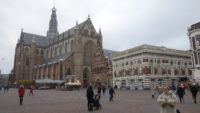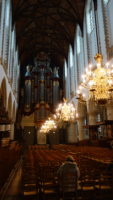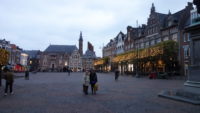 I made a bagel run again this morning, and although I was not passed by any thong-wearing rollerbladers, I did get to see a really buff shirtless man standing in front of his huge window on the third floor. Dubbs has volunteered to get breakfast from now on.
I made a bagel run again this morning, and although I was not passed by any thong-wearing rollerbladers, I did get to see a really buff shirtless man standing in front of his huge window on the third floor. Dubbs has volunteered to get breakfast from now on.
This was another day when Mer was in charge, and we started off fairly early so we could get to the museum campus and the Van Gogh Museum at 9:00, for when our reservations were. There was a thirty-minute window, so our getting there at 9:30 was no issue. We decided to pick up an audioguide that walked us through the highlights of the collection, which took about an hour and a half, which was a perfect amount of time for us today.
The Van Gogh Museum was roughly organized chronologically, although they sometimes had grouped items (like self-portraits) for easier comparison. They’d also dedicated parts of each of the three floors to works by other artists who inspired Van Gogh. It was very useful to see, especially with the help of the audioguide, how Van Gogh’s style developed over time. Van Gogh tried to capture the emotion of a person or scene, and he did this by experimenting more and more with brush textures and using more and more bright colors. He also started using basic colors next to each other, instead of mixing the colors on his paint palette, which forces the viewer to mix the colors with the eye, creating color that is not really there.
 Since the museum has hundreds of letters that Van Gogh wrote, it interwove his history with the history of his paintings, from working in his hometown, to moving to Paris and then to the south of France, to admitting himself into a mental hospital, to finally moving back north to be near his brother, before Van Gogh shot himself in the chest and died two days later. His brother, then his brother’s wife, and finally his nephew worked very hard to make sure that Van Gogh’s work became known, with the nephew’s being instrumental in getting the current museum to be founded and opened.
Since the museum has hundreds of letters that Van Gogh wrote, it interwove his history with the history of his paintings, from working in his hometown, to moving to Paris and then to the south of France, to admitting himself into a mental hospital, to finally moving back north to be near his brother, before Van Gogh shot himself in the chest and died two days later. His brother, then his brother’s wife, and finally his nephew worked very hard to make sure that Van Gogh’s work became known, with the nephew’s being instrumental in getting the current museum to be founded and opened.
We all found it interesting and moving. The only downside was, even in off-season on a random Tuesday, the museum was fairly crowded, making viewing some of the paintings difficult.
We left the museum and actually took the fairly new Metro line to the train station, where we caught the train to the town of Haarlem, about twenty minutes away. Mer wanted to visit the house of Corrie Ten Boom, who, with her family, hid Jews during World War II, and later preached forgiveness and love through Jesus around the world. The museum really was her home, so the museum can only take twenty people at at time, in a first-come, first-served line outside the home. We got there two hours before the next English tour, and Mer was debating about if we should wait in line. Happily, since we were hungry and very, very cold in the wind and high-30s weather, she chose to risk the off-season line, and we went and ate.
 When we got back from lunch, we still had forty minutes to wait, and there was no one in line. We queued up, and by the time we got admitted, it was still just the three of us (although a Canadian couple joined us thirty minutes into the one-hour tour). Our guide was a volunteer who had recently moved with her husband from South Africa. He was hired as a hockey coach, and she was asked at her new church to help out with the tours, and as she had been on the tour once before, she was eager to help out. She was very kind, and it was nice to have such a small group so we could interact with her.
When we got back from lunch, we still had forty minutes to wait, and there was no one in line. We queued up, and by the time we got admitted, it was still just the three of us (although a Canadian couple joined us thirty minutes into the one-hour tour). Our guide was a volunteer who had recently moved with her husband from South Africa. He was hired as a hockey coach, and she was asked at her new church to help out with the tours, and as she had been on the tour once before, she was eager to help out. She was very kind, and it was nice to have such a small group so we could interact with her.
I knew nothing of Corrie when I went in. She and her sister, both in their fifties, along with her father (in his eighties), were deeply devout Christians who had a long history of praying for the people of Israel. So when the Nazis started rounding up Jews, they wanted to help Jews escape the Netherlands. They would open their door to anyone who asked, and helped over eight hundred Jews escape. They had a false closet built at the back of Corrie’s room, accessed by a small sliding door. The entire structure was built of brick so that it would not sound hollow, and could hold up to eight people standing back-to-front, crammed in together.
One day, a man stopped by to ask for money to help his wife get out of jail; he said she had been helping Jews. Corrie told him to come back in the evening, and when her sister went to answer the door in the evening, she heard a car, which tipped her off that the Gestapo was coming (no one else had cars). She hit a hidden buzzer, and four Jews and two resistance fighters fled into the closet. The Germans raided the home, but could not find the hiding place, and so decided to wait out the Jews, waiting about two days while the people in hiding suffered with no light, food, water, or heat in February. The Germans got bored and turned the guarding over to the local police, and as there was one policeman who was sympathetic to the smuggling group, he got the Jews and two other men out and away.
Meanwhile, Corrie and her sister and father were arrested on charges of having too many ration cards. The Nazis offered to let the father go, since he was old, on the condition that he would stop helping Jews, but he refused. He was sent off to a prison camp, where he died ten days later.
The sisters were moved from a jail to a concentration camp north of Berlin once the Allies started closing in. Corrie’s sister remained positive and kept reminding Corrie to forgive. The sister died in the camp, but had two very specific visions of houses where centers of healing would be set up, and one was at the camp in which she died. Both visions were realized after the war, to the point where the owner of the one home was shocked as Corrie described it in minute detail, even though she had never seen it. Corrie went on to tour the world, preaching forgiveness, even to the point of writing to forgive the man who turned her family in. She kept touring most of her life, into her early eighties.
I was amazed at the story. Corrie and her family were giants of the Christian faith, and I had known nothing of them. I was grateful to tour the home.

Afterwards, we went to the town square to tour the cathedral of St. Bavo. It houses a five-thousand-pipe organ, and we were lucky enough to be in the church when someone was practicing for a concert. The acoustics were amazing, even to one of Mer’s little “meeps” sounding during a quiet spell. The cathedral is simple, but impressive, with an intricate wooden ceiling and a very modern stained glass window that was installed in 2015. The floor of the church is all tomb covers, and they are all worn away from foot traffic so that no names are visible anymore.
From church, we swung by a chocolate cafe to get warm (it really was bitterly cold) and then took the train back to Amsterdam. We grabbed a canal tour boat for a one-hour tour of the canals, captained by a funny man who was a skillful sailor, getting the boat into canals not designed for a boat so large. It was pretty to see Amsterdam lit up from the viewpoint of the canals – the houseboats and the canal-facing homes were all very pretty.
 We started walking home, but got very cold and jumped into a restaurant to eat and get warm. Then Dubbs, who thinks of these phone-related things, summoned an Uber driver to get us within a few blocks of home, saving us from a cold walk.
We started walking home, but got very cold and jumped into a restaurant to eat and get warm. Then Dubbs, who thinks of these phone-related things, summoned an Uber driver to get us within a few blocks of home, saving us from a cold walk.
It was a long day, and the weather was not always kind, but we saw a lot of worthwhile places today.